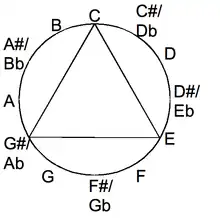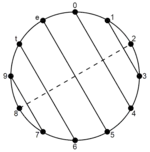






In post-tonal music theory, identity is similar to identity in universal algebra. An identity function is a permutation or transformation which transforms a pitch or pitch class set into itself. Generally this requires symmetry. For instance, inverting an augmented triad or C4 interval cycle, 048, produces itself. Performing a retrograde operation upon the tone row 01210 produces 01210. Doubling the length of a rhythm while doubling the tempo produces a rhythm of the same durations as the original.
In addition to being a property of a specific set, identity is, by extension, the "family" of sets or set forms which satisfy a possible identity. These families are defined by symmetry, which means that an object is invariant to any of various transformations; including reflection and rotation.
George Perle provides the following example:[1]
- "C-E, D-F♯, E♭-G, are different instances of the same interval [interval-4]...[an] other kind of identity...has to do with axes of symmetry [reflection symmetry rather than interval families' rotational symmetry]. C-E belongs to a family [sum-4] of symmetrically related dyads as follows:"
| D | C♯ | C | B | A♯ | A | G♯ | ||||||||
| D | D♯ | E | F | F♯ | G | G♯ | ||||||||
| 2 | 1 | 0 | e | 9 | 8 | 7 | ||||||||
| + | 2 | 3 | 4 | 5 | 6 | 7 | 8 | |||||||
| 4 | 4 | 4 | 4 | 4 | 4 | 4 |
C=0, so in mod12, the interval-4 family:
| C | C♯ | D | D♯ | E | F | F♯ | G | G♯ | A | A♯ | B | |||||||||||||
| G♯ | A | A♯ | B | C | C♯ | D | D♯ | E | F | F♯ | G | |||||||||||||
| 0 | 1 | 2 | 3 | 4 | 5 | 6 | 7 | 8 | 9 | t | e | |||||||||||||
| − | 8 | 9 | 10 | 11 | 0 | 1 | 2 | 3 | 4 | 5 | 6 | 7 | ||||||||||||
| 4 | 4 | 4 | 4 | 4 | 4 | 4 | 4 | 4 | 4 | 4 | 4 |
Thus, in addition to being part of the sum-4 family, C-E is also a part of the interval-4 family (in contrast to sum families, interval families are based on difference).